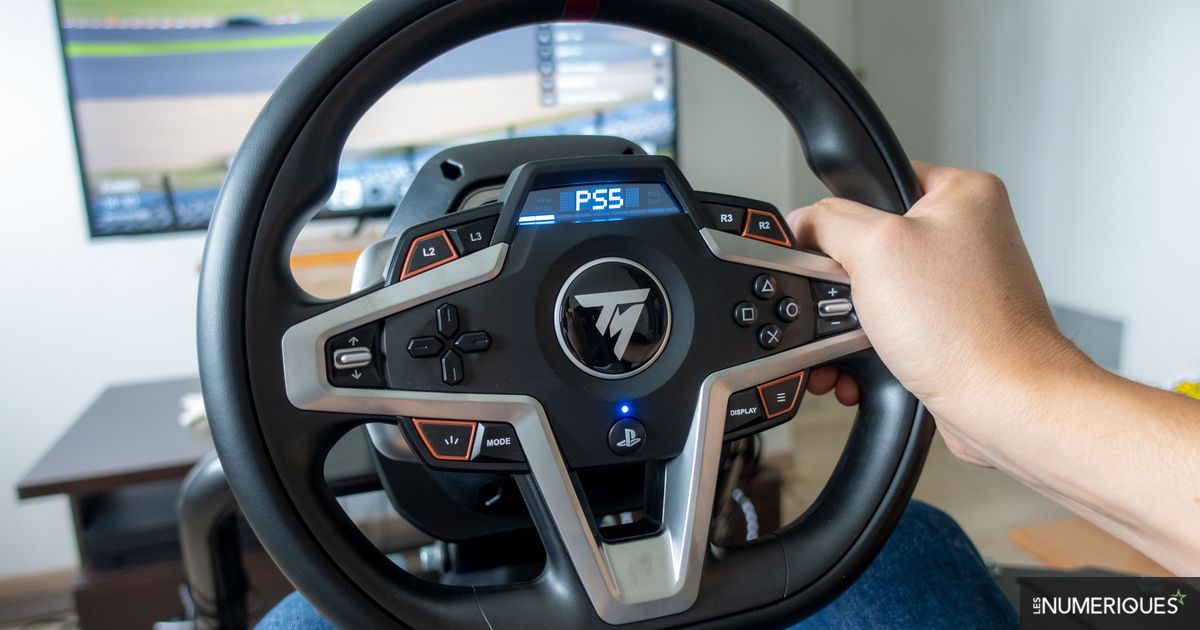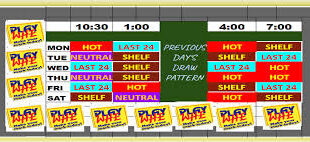Thrustmaster is a venerable name in the gaming space, purveying all manner of racing wheels, joysticks and accessories. At an RRP pf £299.99, the Thrustmaster T248 racing wheel is the company’s latest entry-level model, and it’s in for a tough fight for the podium. That price bracket includes a lot of cool wheels, including my own Logitech G290 0which I’ll be comparing it against quite heavily. And with the release of the new F1 2022, what better time to consider grabbing a wheel and seeing how quickly you can smash into Lewis Hamilton?
First, though, I wanted to quickly talk about how I’m tackling this review. While I love hurling cars around bends, I am not a hardcore enthusiast looking to spend thousands on exotic rigs, triple monitors and my own private pit crew. I’m just looking for something that’s fun, adds to my enjoyment of racing and that isn’t going to cost me my house, my marriage and all that money I got in that bank heist a few years ago. So if you’re a sim-racing lover looking for a review pitting this against dozens of other units on the market, this isn’t it. The premise I want to answer is very simple: if I bought this for the RRP of £299.99, would I feel like I had spent my money well?
The Thrustmaster T248 comes in two console-flavoured specifications: one for the Xbox and one for Playstation. Both are identical except for the symbols on the buttons, and both will also work on PC. Sadly, we still don’t live in a world where we can have a wheel compatible with both consoles, but I imagine that’s also not a huge problem for the majority of people. For this review, I opted for the Xbox version and played a mixture of console and PC titles to get a feel for the wheel. I hit the gravel in DIRT 2.0, blasted around Mexico in Forza Horizon 5, did some wheel-to-wheel racing in Assetto Corsa Competizione and yelled obscenities at my rivals in F1 22 before blaming it all on the car.
First impressions of the Thrustmaster T248 are a little underwhelming. It certainly isn’t lacking in controls – the front of it is peppered with buttons that are all easily reachable. But it also has a slightly toy-ish look to it, like something from a few generations back. The wheel itself measures a paltry 28cm, which does put it in line with most other entry-level wheels on the market, yes, but doesn’t stop it from feeling small. To be honest, that doesn’t bother me much, though, since I drive a Peugeot and they currently have small, almost square steering wheels.
The outer rim is covered in a nice, padded material that feels good to caress and cuddle with, not that I did that. The inside of the wheel, however, is the same black plastic that everything else is constructed of. It makes the wheel look and feels more like a toy than a premium product that costs £300, especially when compared to the leather-wrapped wheel and metal construction of my Logitech G290. It also means you have a noticeable seam sitting right under your palm which you can clearly see in the image above. But there is a big upside to the construction materials: the Thrustmaster T248 is quite light, making it much easier to set up and teardown. And if you have it mounted to a rig that you need to tidy away, those saved kilos can make the job much easier.
A clamp is included in the box so that you can whack this beast onto just about any table. It does an admirable job, too. The wheel felt nice and secure, especially compared to my Logitech G290 clamping system which does the job but always felt a little…iffy. However, for the majority of my time with the Thrustmaster T248 I had it hard mounted to a racing wheel stand so that I can wheel the whole contraption around.
The T248 features a neat little LCD screen atop the centre piece of the wheel. If the game supports it then this wee display can show your lap times, current speed and other information. It’s hardly a big screen so it can’t display much data, but it’s a fun little feature and can add to the immersion, such as in F1 2022 where it could show my a gear-change indicator. On a more practical level, the LCD serves as a small menu screen so that you can quickly flick between some of the wheel’s basic settings on the fly, such as the available rotation and level of force feedback. That’s especially handy on a console where you don’t have access to the Thrustmaster software. There are even three Force Feedback presets to choose from that alter the curve in order to accentuate certain aspects of the handling, although I can’t see I noticed much of a difference between them.
The wheel also features two “encoders” which the manual fails to explain very well. In fact, even the dedicated video that can be found on Youtube doesn’t do a great jump of explaining what these are. I’ll give it a go: on each side, you have two little silver-coloured buttons that can be pressed up or down. The one on the right can be mapped to any two commands you want, like altering brake bias, and the down button on the left encoder can also be mapped. By pressing up on the left encoder you swap between different preset mappings, thus the right encoder could go from changing the camera to being used to handling the MDF in F1. It’s awesome to have the extra flexibility, especially in some games that have heaps of controls, but it is also a little clumsy and very poorly explained.
But obviously, the most important part of the wheel is what’s powering it. Thrustmaster has opted for a hybrid system in the T248, combining belts and gears, which they claim will provide the best of both worlds while mitigating the weaknesses. If you’re at a bit of loss, here’s a basic gist: gear-driven wheels use a small motor and then a series of gears to amplify the power that the motor produces which is delivered to the user as force feedback, creating the sensation that the wheel is fighting against you or reacting to the road surface. A belt works similarly in that a series of belts and pulleys amplify the feedback a small motor produces. As a rule of thumb, gear-driven systems tend to be clunky, a result of having metal on metal, and thus tend to be the cheapest system on the market. Belts tend to be smoother, but also a tad pricier. The ultimate wheels are direct feedback which feature much larger motors capable of producing heaps of power and accurate feedback without the need for gears and belts. You have to be willing to spend a lot of money to get one, though.
So, how does the melding of belts and gears fare in the T248? Pretty well actually. I couldn’t find any official confirmation of how much power the wheel can output aside from Thrustmaster claiming it’s 70% more than its cheaper T148 model, so I only have my own feelings to go on, but I found the T248 more than capable of pumping out enough force feedback for someone like myself. At around 90% FFB the wheel begins to clip, meaning it would start to lose detail and feeling. However, I rarely found myself ever needing to pump it up that high, so it wasn’t an issue. There was plenty of detail in the vibrations and feedback I was getting, giving me a good sense of what the car was doing and of the surface I was driving on, whether that was smooth tarmac or thick gravel.
The way it delivers the force feedback felt pretty smooth. My Logitech G920 uses a basic gear system so when you hit those corners hard the motor will jerk, creating a clunky feeling as you turn the wheel and the unit tries to deliver more oomph. That can hide some of the detail of the handling and tends to be pretty noisy. I often turn the power down just to quieten the unit for fear that the vibrations through the floor might summon Godzilla. Comparatively, the T248 was always quiet and aside from a little bit of friction, it was quite smooth in its delivery. Certainly not as smooth as a pure belt-driven system, but smooth enough for a pleb like me who isn’t trying to set record times in iRacing.
It’s also important to remember that the games themselves play a huge part in how good the feedback feels and whether it natively supports the T248 or it just uses generic wheel settings. In Forza Horizon 5, for example, I ended up doing a lot of tweaking to get the wheel feeling good, whereas in Assetto Corsa Competizione and F1 2022 the base settings were solid and the feedback felt much more detailed.
The only weakness of the T248’s motor and systems is the speed at which it snaps back to the centre. It’s a little slow, something which isn’t a problem in many racing games but can affect performance when rallying in something like DiRT 2.0 or when drifting. When you come sliding out of a hairpin being able to let the wheel snap back to the centre is a key skill. I definitely missed the quicker centring of my Logitech in Dirt 5 and even Wreckfest. It’s not a deal-breaker for most people, but if you plan on doing a lot of drifting or odd-roading you might want something snappier.
The other problem is, to my mind, the biggest one the T248 faces. I’m referring to its magnetic gear shifters which suffer from a horrendously, OBNOXIOUSLY loud clack when used. This stems from the shifter snapping back into place after you pull it. It’s distracting if you aren’t using headphones and loud enough to annoy everyone else in your house. In fact, it could even be loud enough for the neighbours to hear if you live in an apartment. The thwack of the paddles is bad enough to have caused people to find ways to dampen the sound, including place an o-ring between the paddle and the shell of the wheel, a solution I can vouch for.
But they do at least feel quite good. Their plastic construction means they don’t feel quite as nice in the hand as the metal ones of my Logitech G290, but it doesn’t take much to pull them and they shift quickly. In fact, Thrustmaster claims they’ll shift gears in 30ms, which I’m going to take their word for because I can’t count. And despite my own qualms about the volume of the shifters, there are people out there for whom the click might be satisfying, especially when wearing headphones.
More advanced tweaking requires the use of Thrustmaster’s software on PC. It would best be described as a service application that looks like it was designed years ago and forgotten about. A visual overhaul is definitely needed to get the whole thing looking like a modern program.
Down on the floor, your feet get treated to the best part of the whole package: the pedals. Unlike Thrustmaster’s cheaper sets these feature accelerator, brake and clutch pedals, providing a lot more room to grow your racing skills. Again, the plastic construction of the board and the pedal stems doesn’t exactly scream premium product, but much like the wheel, the slightly cheap materials hide good performance. These feel great to use and feature magnetic sensors. That means they’ll remain accurate for far longer than the pots found on other pedals where the moving pieces eventually take their toll on the sensors, reducing the overall accuracy of braking and accelerating. In fairness, the average person probably wouldn’t notice unless they used the pedals for hours a day, but it’s still awesome to know that these pedals should last a long time.
The brake pedal has a total of four different stiffness settings that you can fiddle with. By default, it comes with the softer spring, but in the box there’s a harder black spring Changing the spring out is extremely easy and I love having the flexibility it provides. My Logitech G290 has an incredibly stiff brake, so much so that I actually find it hard to hit 100% braking and it can only be changed through some modding. My nieces also like to mess about on Forza Horizon and the softer spring is a far better choice for them, and I can always swap back to the harder one.
Be warned, though, if you aren’t mounting the pedals to anything they can slide along the floor easily. There are no deployable carpet spikes to help hold them in place, so when you slam that brake pedal to avoid imminent disaster the rear of the pedals can rise up and the whole unit can move. For this reason, I’d keep the softer spring in place unless you can mount the pedals or jam them up against something. If you want a middle-ground solution, a non-slip mat is a good choice and they can usually be found quite cheap. If you can get the pedals mounted or held securely enough the second spring is the ideal choice as it provides a very nice feeling of resistance, whereas with the softer spring it can be hard to find the balance between braking and locking up the wheels.
Overall, I think these pedals are great for the money. The plastic construction does raise a concern about them breaking under pressure, but I haven’t seen any complaints about that from long-term users.
When it comes to upgrading the Thrustmaster T248 isn’t as flexible as other models on the market. The wheel itself can’t be swapped out, for example, and the only compatible gear shifter is Thrustmaster’s very own TH8A which still sells for £150+ new despite being years old. It’s mostly made of metal and is therefore very durable, but Logitech offers a far more affordable £40 shifter for their wheels which is a much better choice for the average person looking to up the immersion factor without completely decimating their bank account balance.
For the average user, I think the T248 is a great piece of kit. The wheel and pedals provide enough performance that you probably won’t feel the need to upgrade unless you happen to discover a deep love for sim-racing that warrants going to the higher-tier equipment, at which point your soul is lost anyway. And the relatively lightweight design of the T248 makes it quite easy to grab out of the cupboard and set up for anyone who doesn’t have the space to just leave it up between sessions. There are slightly cheaper wheels on the market, but that means getting a far worse set of pedals or having to go for a 100% gear-driven system. For a little more cash you could get Thrustmaster’s own T300 which has a belt-driven system and more oomph, but it only comes with a very basic two-pedal setup unless you hand over even more money. You could also go down the Logitech route with the G920 or G923, but the tradeoff is rougher force feedback.
Overall, the Thrustmaster T248 is a great entry-level wheel that is going to be an awesome choice for anyone looking to upgrade from a controller. Going from analogue sticks and triggers to a proper wheel and peddles is a night and day difference, like going from a Ford Kia to a Skyline GTR. So to answer my own question, would I feel like £300 was well spent on the T248? Aside from a few flaws, I’d be more than happy to race with it.
 Lifeyet News Lifeyet News
Lifeyet News Lifeyet News





